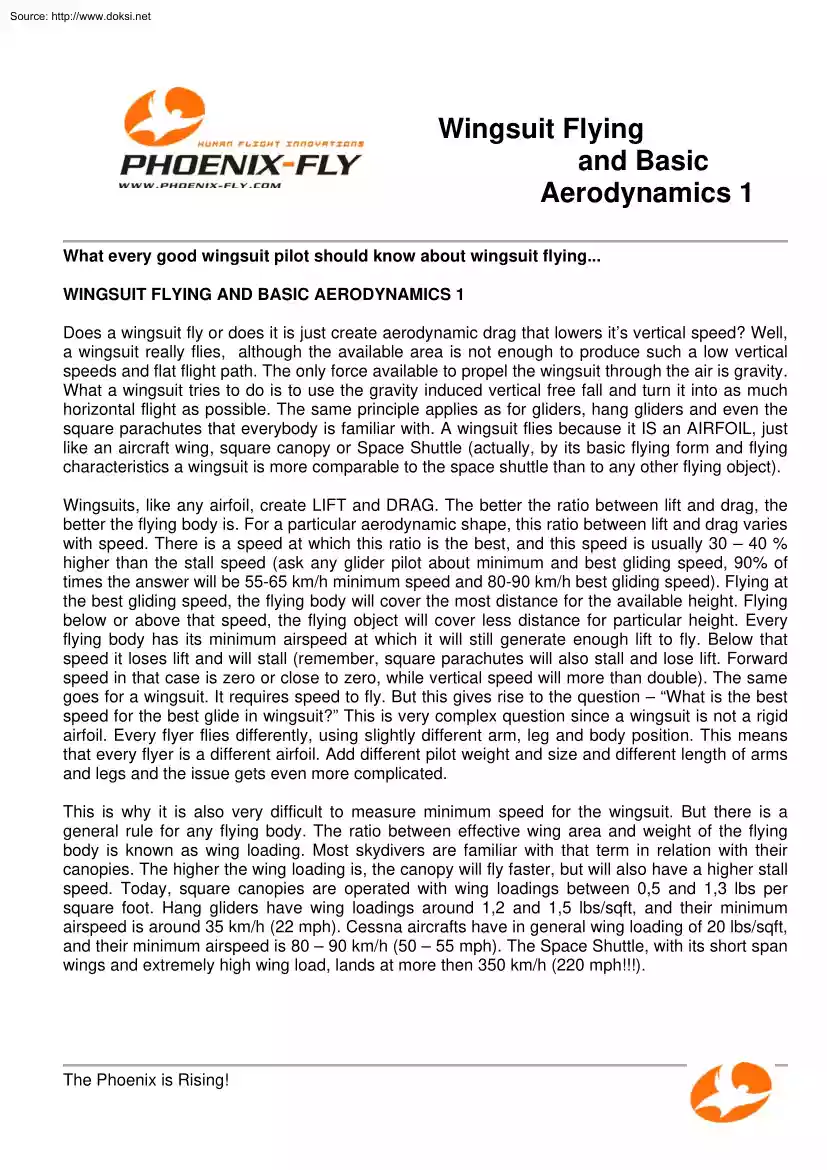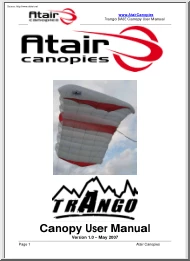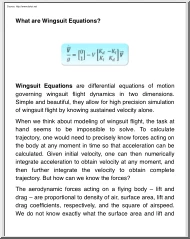Datasheet
Year, pagecount:2005, 2 page(s)
Language:English
Downloads:2
Uploaded:January 14, 2019
Size:489 KB
Institution:
-
Comments:
Phoenix Fly
Attachment:-
Download in PDF:Please log in!
Comments
No comments yet. You can be the first!Most popular documents in this category
Content extract
Source: http://www.doksinet Wingsuit Flying and Basic Aerodynamics 1 What every good wingsuit pilot should know about wingsuit flying. WINGSUIT FLYING AND BASIC AERODYNAMICS 1 Does a wingsuit fly or does it is just create aerodynamic drag that lowers it’s vertical speed? Well, a wingsuit really flies, although the available area is not enough to produce such a low vertical speeds and flat flight path. The only force available to propel the wingsuit through the air is gravity What a wingsuit tries to do is to use the gravity induced vertical free fall and turn it into as much horizontal flight as possible. The same principle applies as for gliders, hang gliders and even the square parachutes that everybody is familiar with. A wingsuit flies because it IS an AIRFOIL, just like an aircraft wing, square canopy or Space Shuttle (actually, by its basic flying form and flying characteristics a wingsuit is more comparable to the space shuttle than to any other flying object). Wingsuits,
like any airfoil, create LIFT and DRAG. The better the ratio between lift and drag, the better the flying body is. For a particular aerodynamic shape, this ratio between lift and drag varies with speed. There is a speed at which this ratio is the best, and this speed is usually 30 – 40 % higher than the stall speed (ask any glider pilot about minimum and best gliding speed, 90% of times the answer will be 55-65 km/h minimum speed and 80-90 km/h best gliding speed). Flying at the best gliding speed, the flying body will cover the most distance for the available height. Flying below or above that speed, the flying object will cover less distance for particular height. Every flying body has its minimum airspeed at which it will still generate enough lift to fly. Below that speed it loses lift and will stall (remember, square parachutes will also stall and lose lift. Forward speed in that case is zero or close to zero, while vertical speed will more than double). The same goes for a
wingsuit. It requires speed to fly But this gives rise to the question – “What is the best speed for the best glide in wingsuit?” This is very complex question since a wingsuit is not a rigid airfoil. Every flyer flies differently, using slightly different arm, leg and body position This means that every flyer is a different airfoil. Add different pilot weight and size and different length of arms and legs and the issue gets even more complicated. This is why it is also very difficult to measure minimum speed for the wingsuit. But there is a general rule for any flying body. The ratio between effective wing area and weight of the flying body is known as wing loading. Most skydivers are familiar with that term in relation with their canopies. The higher the wing loading is, the canopy will fly faster, but will also have a higher stall speed. Today, square canopies are operated with wing loadings between 0,5 and 1,3 lbs per square foot. Hang gliders have wing loadings around 1,2
and 1,5 lbs/sqft, and their minimum airspeed is around 35 km/h (22 mph). Cessna aircrafts have in general wing loading of 20 lbs/sqft, and their minimum airspeed is 80 – 90 km/h (50 – 55 mph). The Space Shuttle, with its short span wings and extremely high wing load, lands at more then 350 km/h (220 mph!!!). The Phoenix is Rising! Source: http://www.doksinet Wingsuit Flying and Basic Aerodynamics 1 For the average person, the wingsuit wing area is 15 – 16 sqft, and the weight is 170 – 190 lbs. This gives us a wing loading of 10,5 – 12,5 lbs/sqft, ten times higher than a square canopy. Some basic maths will tell us that with a wing loading ten times higher, the minimum airspeed will be roughly 3 times higher. This is consistent with measurements of wingsuit flights, where the best glide ratio are achieved at airspeeds of approx. 130 km/h (75 mph) At that airspeed the vertical speed was 40 – 50 km/h, resulting in glide ratio between 2 and 2,5. You can go for lower
vertical speed, but that will also result in significantly lower horizontal speed and poor glide ratio. Regarding attempts to land a wingsuit, a much bigger wing area will be needed to generate more lift and reduce minimum airspeed. But the human body has definite shape, which is not suited for flight at all, and well need at least a few million years of evolution effort to change it to a more appropriate shape for wingsuit flying. That means that wingsuit potential for more lift is limited by the inadequate human shape and available strength. The only option for more lift will be some kind of rigid wing, but we already have these. They are called airplanes Also, if you are still thinking of landing the wingsuit, do one normal parachute jump, but when you open the canopy, try to position your body horizontally (can be done by hooking your feet around rear risers) and try to land a small elliptical canopy in that position. After that painful experience, multiply the pain and injuries by
9 (three times the speed = nine times the forces of impact = 9 times the consequences), and decide if you are willing to give it a try. The Phoenix is rising The Phoenix is Rising!
like any airfoil, create LIFT and DRAG. The better the ratio between lift and drag, the better the flying body is. For a particular aerodynamic shape, this ratio between lift and drag varies with speed. There is a speed at which this ratio is the best, and this speed is usually 30 – 40 % higher than the stall speed (ask any glider pilot about minimum and best gliding speed, 90% of times the answer will be 55-65 km/h minimum speed and 80-90 km/h best gliding speed). Flying at the best gliding speed, the flying body will cover the most distance for the available height. Flying below or above that speed, the flying object will cover less distance for particular height. Every flying body has its minimum airspeed at which it will still generate enough lift to fly. Below that speed it loses lift and will stall (remember, square parachutes will also stall and lose lift. Forward speed in that case is zero or close to zero, while vertical speed will more than double). The same goes for a
wingsuit. It requires speed to fly But this gives rise to the question – “What is the best speed for the best glide in wingsuit?” This is very complex question since a wingsuit is not a rigid airfoil. Every flyer flies differently, using slightly different arm, leg and body position This means that every flyer is a different airfoil. Add different pilot weight and size and different length of arms and legs and the issue gets even more complicated. This is why it is also very difficult to measure minimum speed for the wingsuit. But there is a general rule for any flying body. The ratio between effective wing area and weight of the flying body is known as wing loading. Most skydivers are familiar with that term in relation with their canopies. The higher the wing loading is, the canopy will fly faster, but will also have a higher stall speed. Today, square canopies are operated with wing loadings between 0,5 and 1,3 lbs per square foot. Hang gliders have wing loadings around 1,2
and 1,5 lbs/sqft, and their minimum airspeed is around 35 km/h (22 mph). Cessna aircrafts have in general wing loading of 20 lbs/sqft, and their minimum airspeed is 80 – 90 km/h (50 – 55 mph). The Space Shuttle, with its short span wings and extremely high wing load, lands at more then 350 km/h (220 mph!!!). The Phoenix is Rising! Source: http://www.doksinet Wingsuit Flying and Basic Aerodynamics 1 For the average person, the wingsuit wing area is 15 – 16 sqft, and the weight is 170 – 190 lbs. This gives us a wing loading of 10,5 – 12,5 lbs/sqft, ten times higher than a square canopy. Some basic maths will tell us that with a wing loading ten times higher, the minimum airspeed will be roughly 3 times higher. This is consistent with measurements of wingsuit flights, where the best glide ratio are achieved at airspeeds of approx. 130 km/h (75 mph) At that airspeed the vertical speed was 40 – 50 km/h, resulting in glide ratio between 2 and 2,5. You can go for lower
vertical speed, but that will also result in significantly lower horizontal speed and poor glide ratio. Regarding attempts to land a wingsuit, a much bigger wing area will be needed to generate more lift and reduce minimum airspeed. But the human body has definite shape, which is not suited for flight at all, and well need at least a few million years of evolution effort to change it to a more appropriate shape for wingsuit flying. That means that wingsuit potential for more lift is limited by the inadequate human shape and available strength. The only option for more lift will be some kind of rigid wing, but we already have these. They are called airplanes Also, if you are still thinking of landing the wingsuit, do one normal parachute jump, but when you open the canopy, try to position your body horizontally (can be done by hooking your feet around rear risers) and try to land a small elliptical canopy in that position. After that painful experience, multiply the pain and injuries by
9 (three times the speed = nine times the forces of impact = 9 times the consequences), and decide if you are willing to give it a try. The Phoenix is rising The Phoenix is Rising!





